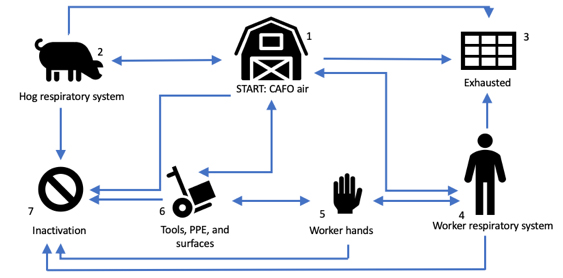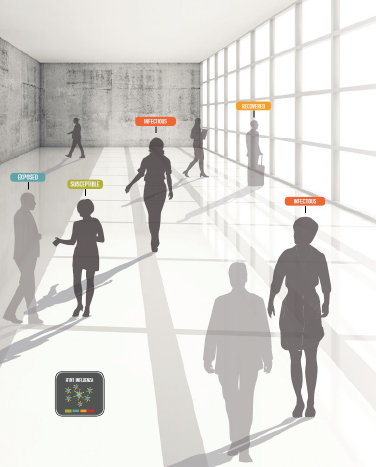Modeling of Infectious Diseases

Recent infectious disease outbreaks have proven to be both deadly and costly. Research demonstrates that workplace transmission plays an important role in propagating infectious disease both within the workplace and into the community. Two important examples of this are (1) concentrated animal feeding operations (CAFOs) and livestock-associated Staphylococcus aureus (S. aureus) infections, and (2) hospitals and human noroviruses (HuNoVs). Although the workplace functions as a major reservoir for many infectious diseases, methodologies for estimating occupational exposures to infectious agents and developing data-driven workplace controls are scant. Consequently, workplace risk management strategies are typically ad hoc and not based on data, resulting in workplace controls that are either over-protective (wasting resources), or, more often, under-protective (putting workers at risk). The effects of ineffective risk management extend beyond the occupational environment when uncontrolled workplace exposures introduce disease into the community. Close contacts of workers who are exposed to hazards in the workplace can have elevated risk of disease through second-hand exposure. While important, there are few data on these worker-to-household and worker-to-community pathways of exposure to infectious agents. Although it has not been studied or quantified, it is reasonable to expect that improved workplace controls will decrease infectious disease transmission in the general population.
The goal of this research is to develop a suite of mathematical models to estimate worker exposure to infectious agents in the workplace, characterize the potential for workers to transmit infections to their household members and general population. This will be accomplished through the following aims:
Aim 1: To develop and validate a mathematical modeling framework for occupational exposure to pathogens in the workplace and propose workplace interventions. We will combine (1) well-established inhalation models of exposure (e.g. the well mixed room, near field/ far field, and eddy diffusion models), (2) dermal models of exposure (e.g. RISKOFDERM), and (3) detailed infectious particle dynamics using Markov chain techniques. The model framework will account for all significant determinants of exposure, which will allow us to identify effective interventions and quantify the potential reduction in exposure.
Aim 2: To quantitatively estimate the potential for workplace infections to spread to household contacts. The effect of taking home clothing/personal protective equipment, household hygiene, and household crowding on disease spread within the household will be modeled using Markov chains. Based on the output of the model, we will develop recommendations to workers that will reduce take-home exposures and protect household members from exposure.
Aim 3: To develop an infectious disease compartment model to estimate the potential for community exposure. The model will incorporate infectious disease dynamics with environmental exposure parameters, such as dispersion of microbial agents.
The suite of predictive models will be used to evaluate the effectiveness of proposed control measures. We hypothesize that risk management strategies that address pathogens in the workplace will significantly reduce exposure to workers, their household contacts, and nearby communities. We will develop and validate these models with previously collected data from several CAFOs throughout North Carolina and data currently being collected at Johns Hopkins Medical Institutions (JHMI) in Baltimore, Maryland. THE CAFO data includes surface and air concentrations of Staphylococcus aureus (S. aureus) bacteria in the workplace; nasal carriage of S. aureus in workers, household members, and community controls; and physical parameters, such as facility dimensions, air ventilation rate, size of infectious particles, number of animals, and meteorological data. The JHMI data will include surface concentrations of HuNoVs on high touch surfaces in patient rooms and general unit areas, experimental data on the survival and transfer efficiency of HuNoVs on multiple surface types, and the generation rate of norovirus particles during aerosol generating events (vomiting, toilet flushing, etc). The proposed research will result in models that can be adapted for use by risk managers at all levels to implement appropriate strategies to mitigate the exposure to infectious disease. Further, these models will provide insight on the importance of the occupational setting as an area to target interventions when seeking to control emerging epidemics.

